Design and installation of ventilation systems: the best schemes + installation nuances
High-quality air exchange is necessary for any residential or household facility. To do this, you need to calculate its parameters and make a diagram of the passage of air flows through the room. Depending on the complexity of the work, the installation of ventilation systems can be done independently or ordered their implementation.
We will tell you how ventilation systems are designed, and list which regulatory documents should be relied on. From our article you will learn how to choose the most suitable scheme. Our recommendations will help both those who decided to do all the work with their own hands, and those who will control the builders.
The content of the article:
Norms for determining air exchange parameters
Since the ventilation system affects the quality of human life, its permissible parameters are spelled out in regulatory documents. Compliance with these requirements is mandatory in the case of commercial use of premises, as well as upon acceptance of multi-apartment buildings.
When the owner designs the ventilation inside the apartment or for a private house, they can be accepted at the recommendation level.
Documents and acts of the Russian Federation
Russian legislation establishes various standards for ventilation and air conditioning, depending on the type and purpose of the premises. They are included in the codes of rules (SP), state standards (GOST) and sanitary rules and norms (SanPiN).
According to the rules, premises for residential and domestic use are ventilated to achieve the following goals:
- Maintenance of oxygen. A decrease in its concentration worsens the well-being of a person. This problem is easiest to solve with an influx of street air.
- Removal of unwanted gases and aerosols. The accumulation of carbon dioxide, combustion products or dust is hazardous to health.
- Climate control. Maintaining humidity in a given range using ventilation is a common and effective method that is often used not only in residential, but also in storage and basements for various purposes.
In Russian standards, the calculation of the supply air flow is determined by many parameters, after which they take the highest indicator. In practice, not all of them are often used, so this approach raises many questions among specialists.
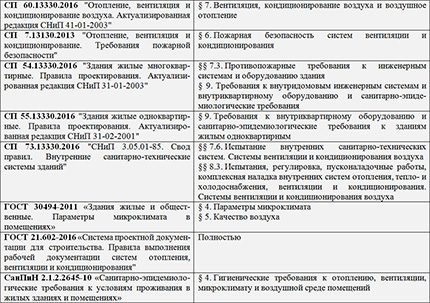
Foreign ventilation quality standards
When installing ventilation systems for the cottage or your own apartment, it is not necessary to use the current Russian regulatory documents. As an alternative, the provisions of foreign standards that regulate indoor air quality can be used in the calculations.

ASHRAE has developed the following documents:
- ASHRAE 62.1 - requirements for ventilation and air conditioning systems;
- ASHRAE 55 - requirements for the microclimate and thermal comfort of the room.
The studies of this American Society of Engineers are often used to calculate quality standards at international and national levels.
To determine the minimum ventilation rates, Standard 62.1 uses techniques based on the following indicators:
- air exchange rate (VRP), where they regulate the position of the supply and exhaust devices and vary the power of the flows depending on the microclimate;
- Internal Air Quality (IAQP), which provides methods for reducing the concentration of unwanted aerosols by filtering them;
- dimensions and position of openings for natural ventilation (NVP).
The integrated use of all three approaches can significantly reduce operating costs.
There is also the work of the European Committee for Standardization (CEN) on building ventilation:
- standard EN 13779 - requirements for ventilation and air conditioning systems;
- standard EN 15251 - requirements for microclimate parameters;
- Act CR 1752 - Calculation criteria for building ventilation.
Both sets of standards relate directly to the health and comfort of users. The required amount of supply air is determined by carbon dioxide emissions, as there are no other significant sources of pollution.
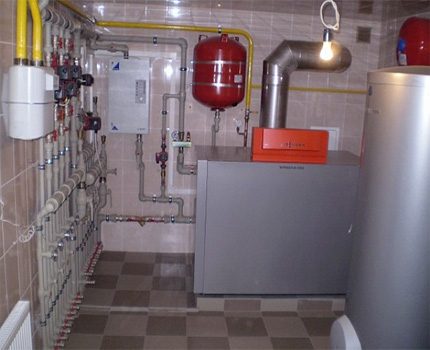
You can order the calculation of ventilation parameters of an apartment or house according to American or European standards. This will be reasonable, given the long foreign experience and more stringent requirements for quality of life.
The main stages of design
Typical schemes for residential and domestic premises are absent due to the architectural and functional variety of buildings.
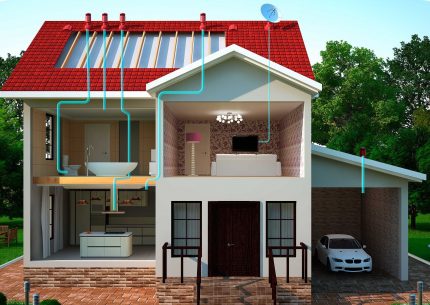
Development of technical specifications
Preparation of technical specifications - the first stage of ventilation design. Here it is necessary to write down the requirements for the volume and type of air exchange for all rooms of the house.
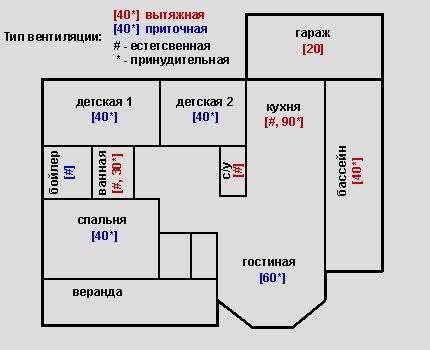
For each individual room, depending on its purpose, determine air exchange parameters.
So, for apartments and private houses use ventilation as follows:
- Living rooms, living rooms, gyms. Constant inflow. The volume depends on the average daily number of people in the room. Possible requirements for temperature and humidity of the incoming stream.
- Bathroom, washroom, laundry. Permanent natural extract. The operation of mechanical devices during room use.
- Kitchen. Permanent natural extract. The inclusion of forced draft during heavy use of gas, or in the case of significant emissions of steam into the air with open cooking methods.
- Corridor and hallway. Free movement of air.
- Pantry. Natural exhaust ventilation.
- Boiler room or furnace. When calculating the air balance, it is necessary to take into account the fact of the presence of exhaust ventilation due to the removal of combustion products through the chimney.
- Workrooms (workshop, garage). Autonomous ventilation, depending on the purpose of the rooms.
The terms of reference can be developed independently or by third-party specialists. In the latter case, at the conclusion of the contract, the designers will have to adhere to the Russian regulatory documents air duct speed and air exchange rate.
Choosing the best ventilation scheme
Based on the technical specifications create a scheme of the ventilation system. The layout plan of its elements must be agreed upon before interior decoration. Otherwise, in the case of installation after repair, there will be an additional task of entering them into the interface of the house.
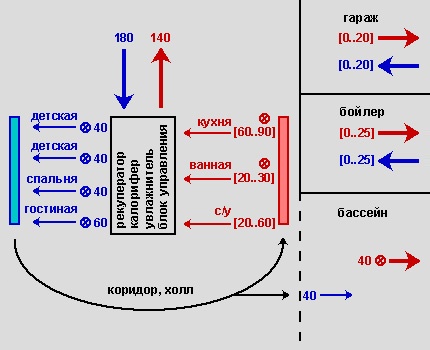
Typically, any ventilation plan can be implemented in several ways.
The best solution should fully meet the requirements of the technical specifications and take into account the following wishes:
- contain a minimum number of nodes and elements that are prone to breakdowns;
- regular maintenance should be simple and, if possible, carried out by residents;
- the use of ventilation when regulating the microclimate should be understandable for people who do not have special knowledge about the technical nuances of the system;
- availability of backup solutions in case of failure of one of the nodes;
- the system should be seamlessly integrated into the interior of the apartment or house.
When making financial calculations, it is necessary to take into account both a one-time investment in the purchase of system elements and their installation, as well as the regular costs of periodic maintenance and the energy spent on heating and humidifying the air.
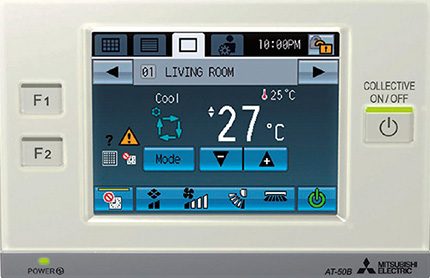
Installation of system components
Like design, installation of ventilation systems can be done independently or entrusted to specialists. To make a decision on this issue, it is necessary to determine the list of works and assess the possibility of their implementation on their own.
Installation of ventilation equipment
With any ventilation schemes, the installation sequence includes the following steps:
- installation of equipment indoors;
- arrangement of supply and exhaust openings;
- laying of air ducts;
- system performance test.
There are many types of equipment that are used in ventilation systems. When using monoblock installations, as well as if it is possible to group most of the devices in one place, they are placed in a ventilation chamber - a specially allocated room.
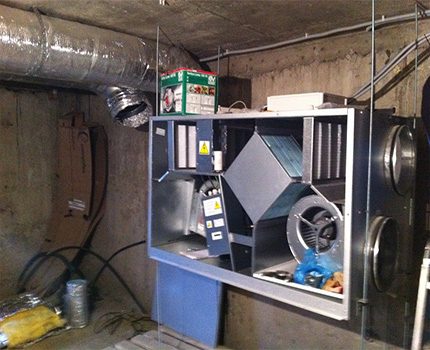
The main nuances of installing internal equipment are as follows:
- Monoblock devices, as well as individual heat recuperators, are heavy. Their installation and reliable fastening is necessary to prevent vibrations. In addition, you need to provide access to them for maintenance work.
- Wiring. Heaters and fans are better allocated in a separate group from the internal electrical panel. For a private home, it is important to provide for the possibility of connecting an autonomous generator.
- Electronic control units must be connected using a voltage stabilizer.
Thus, for the independent installation of ventilation equipment, general building skills and practical experience in electrician are necessary.
Organization of air flow
The intake of street air can occur either in one place with its subsequent distribution in the duct system or for each room separately. In the first embodiment, the main branches of the supply and exhaust ducts are usually located close to each other, separating only on the street.
Room independent forced ventilation implemented in two ways:
- installation of a bypass valve of a window type;
- mounting a wall valve.
Ready-made solutions that are associated with the passage of air through the windows, have certain specifics. With severe cooling in the places of air intake, ice forms, which quickly disables such valves.
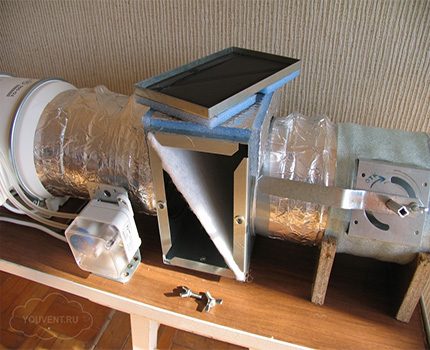
In addition, cold air without heating and dispersion descends to the floor, creating a vertical temperature gradient. This reduces the level of thermal comfort and increases the risk of colds.
The wall valve is less susceptible to freezing and can be equipped with a heater for heating the air and a deflector for dispersing it.
When installing such a device, the following issues must be resolved:
- Drill a hole with some outward slope. In panel houses, this can only be done by applying diamond drilling technology. As a result of the work, a large amount of dust will be produced, which must be collected using a vacuum cleaner.
- Solve the issue of valve insulation. Checking its quality will take place during the first severe frosts, when remaking anything will be very difficult.
- Install the outer grill. This causes problems when the apartment is not located on the ground floor. Safety precautions must be observed here.
- If you need to integrate a fan, air heater or humidifier into the valve, you will need to ensure that the devices are connected to electricity.
The wall valve head must be selected taking into account the interior. If necessary, it can be easily painted.
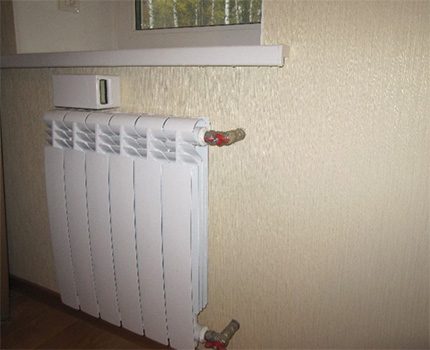
The nuances of the exhaust ventilation device
The main work on exhaust ventilation in the apartment are as follows:
- bringing the duct (usually only in the kitchen) to the ventilation shaft;
- installation of hoods in the kitchen and fans in the bathroom and the restroom.
When installing exhaust ventilation in a private house, in addition to these works, it is necessary to perform more complex:
- laying ducts through the attic with their insulation;
- vent output to the roof with the installation of the pipe.
Warming of channels that are designed to remove air is necessary to prevent condensation from falling out and return it through the ventilation back to the room.In this case, it is desirable to set the mine cross section based on the average flow velocity of at least 1 m / s. It also helps to remove excess moisture.
When venting to the roof, the following conditions must be met:
- identify permissible ventilation outlet points and calculate the pipe length;
- make the passage of the pipe through the roof with the restoration of hydro and thermal insulation;
- to fix the pipe well on the roof in order to avoid its distortion or tipping over in strong winds;
- Install a deflector to protect ventilation from precipitation and increase traction.
All work performed on pitched roofs must be carried out in compliance with safety measures. It is also necessary to prevent damage to the roof.
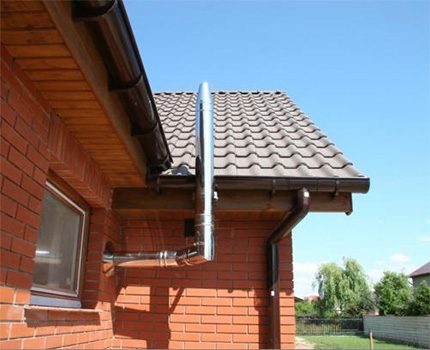
Duct construction and start-up tests
Between rooms, air transfer can occur in the usual way, or by ventilation ductsinstallation of which is a simple task. It can be performed independently with minimal construction and repair skills.
For domestic purposes, use plastic, thin-walled metal or flexible corrugated ducts. The connection of the shaped elements with each other does not cause difficulties, however, additional sealing of the joints with the use of self-adhesive tape or silicone sealant will not be superfluous.
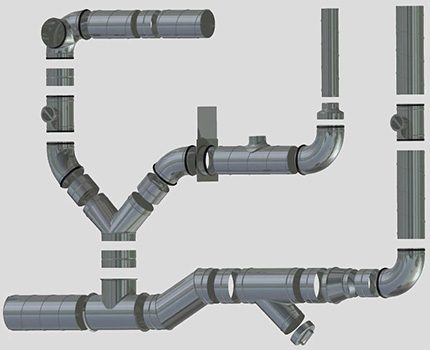
Parts mounted ducts, depending on the location, are attached as follows:
- When attaching to the wall and ceiling, special clamps are used, which are sold complete with an air duct or separately. They are cheap, so there is no need to come up with other ways.
- If the duct lies on cabinets or kitchen shelves, then it is fixed using any holders. Foam is placed under the parts to prevent rattling during ventilation.
- Inside the cabinets, the duct parts are fixed with clamps. In places of passage through partitions and walls, they are surrounded with foam or foam inserts to eliminate noise.
After connecting the air ducts to the hoods, supply air valves and ventilation equipment, it is necessary to check the operability of the entire system.
This must be done in the following modes:
- maximum power of all devices;
- maximum power of supply ventilation with inoperative exhaust devices;
- maximum power of exhaust ventilation with inoperative supply devices.
The first mode is used to verify the sufficiency of power supply and the integrity of the duct system. The last two modes are necessary to check the possibility of reverse thrust and intensive air filtration through the walls.
Despite all the calculations, some supply and exhaust fans may not correspond to the declared characteristics, which is difficult to identify in the process of their operation.
Conclusions and useful video on the topic
Ventilation scheme for typical rooms. Rules for the supply and exhaust ventilation:
Installation of duct duct systems and their section selection. The use of heat recuperators:
The calculation of the required volume of air circulation, the preparation of a ventilation plan and its installation can be fully or partially carried out independently. When ordering such services from specialists, an understanding of the nuances of these procedures will allow us to control the quality of the work performed.
Want to share your own experience in the design and installation of ventilation in a country house or in the country? Do you have information that will be useful to interested visitors to the site? Please write comments in the block below, post photos and ask questions about the topic of the article.

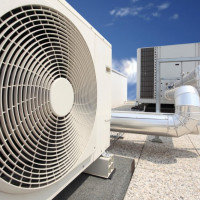 Design of building air conditioning systems: important nuances and stages of the design
Design of building air conditioning systems: important nuances and stages of the design 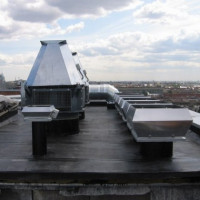 Schemes for arranging ventilation systems in an apartment building
Schemes for arranging ventilation systems in an apartment building 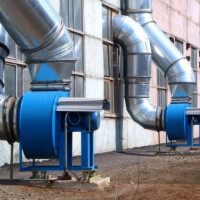 Types of ventilation systems: a comparative overview of the options for organizing ventilation systems
Types of ventilation systems: a comparative overview of the options for organizing ventilation systems 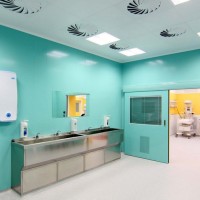 Cleanroom ventilation: design and installation rules for ventilation systems
Cleanroom ventilation: design and installation rules for ventilation systems 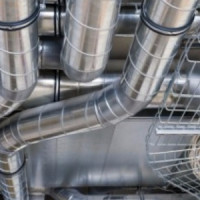 Arrangement of ventilation to the ceiling: types of ventilation systems and features of their arrangement
Arrangement of ventilation to the ceiling: types of ventilation systems and features of their arrangement 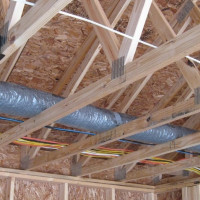 Ventilation in the house from sip panels: the best options and layouts
Ventilation in the house from sip panels: the best options and layouts  How much does it cost to connect gas to a private house: the price of organizing gas supply
How much does it cost to connect gas to a private house: the price of organizing gas supply  The best washing machines with dryer: model rating and customer tips
The best washing machines with dryer: model rating and customer tips  What is the color temperature of light and the nuances of choosing the temperature of the lamps to suit your needs
What is the color temperature of light and the nuances of choosing the temperature of the lamps to suit your needs  Replacement of a geyser in an apartment: replacement paperwork + basic norms and requirements
Replacement of a geyser in an apartment: replacement paperwork + basic norms and requirements
In a private multi-room house, he independently made ventilation. Naturally, he did not report to anyone and no one did the acceptance. How to find out the correct calculation ?! It turned out that in the summer, on the sunny side, even open windows do not save from stuffiness. In winter, too hard to breathe without a window. They put in addition two air conditioners. On the north side, everything is ok in both winter and summer.
If you do not have normal ventilation in the apartment without the air conditioner turned on, then the calculations were incorrect. Accordingly, ventilation does not work correctly, based on your current situation, we can conclude: you need fresh air ventilation.
Honestly, I don’t understand this saving a bit: do not call a ventilation specialist to do everything by standards and with a guarantee, but then buy as many as two air conditioners in order to somehow provide an influx of fresh air.
It is possible that in your case it will be enough to mount the supply ventilation valves directly on the windows. There are also options that are mounted on the side or under the windows, the air flow can be regulated.